UTC2105 - Singapore as a ‘Model’ City Group 3
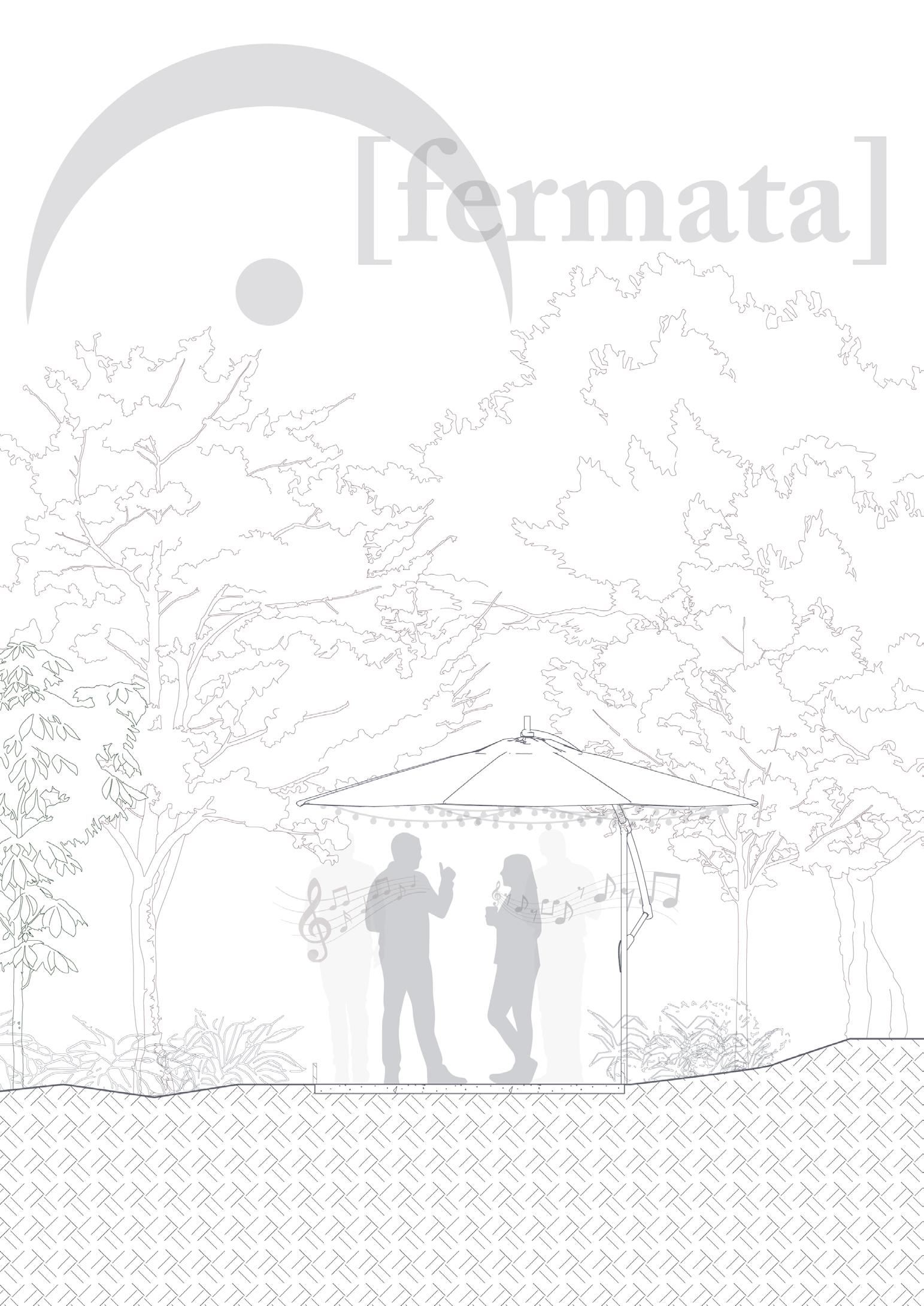
Fermata - Project Report

2 UTC2105 - Singapore as a ‘Model’ City Contents Concept and Aims Form, Development and Set Up Form Site Analysis Set Up Impacts and Insights Observation of Public Interactions Site Observation Interviews and Surveys Result Analysis Public Reception Conclusion Summary of Findings Implications of the Intervention Recommendations and Improvements References Appendixes Music Selection Site Study Survey Questions and Results Interview Transcripts Reflections “Without a song, the day would never end.” - Elvis Presley 4 6 6 6 7 9 9 12 13 16 19 22 22 22 22 23 24 24 29 29 30 33
Members
Faith Chng
Marcus Loh Men Tong
Tran Hieu Nghia

3 Project Report - Group 3 Fermata
From left to right: Marcus, Faith, Nathan
UTC2105 - Singapore as a ‘Model’ City
Concept and Aims
In musical theory, the fermata “ ” is a symbol that signifies a prolonged pause at the discretion of the performer on a note or rest. Our intervention of the same name aims to encourage passersby to slow down along the transitory path by providing shelter, visual and audio stimuli to create a moment of temporary respite in an unrepeatable “ichi-go ichi-e”1 moment. The musical symbol also resembles an umbrella sheltering a person’s head.
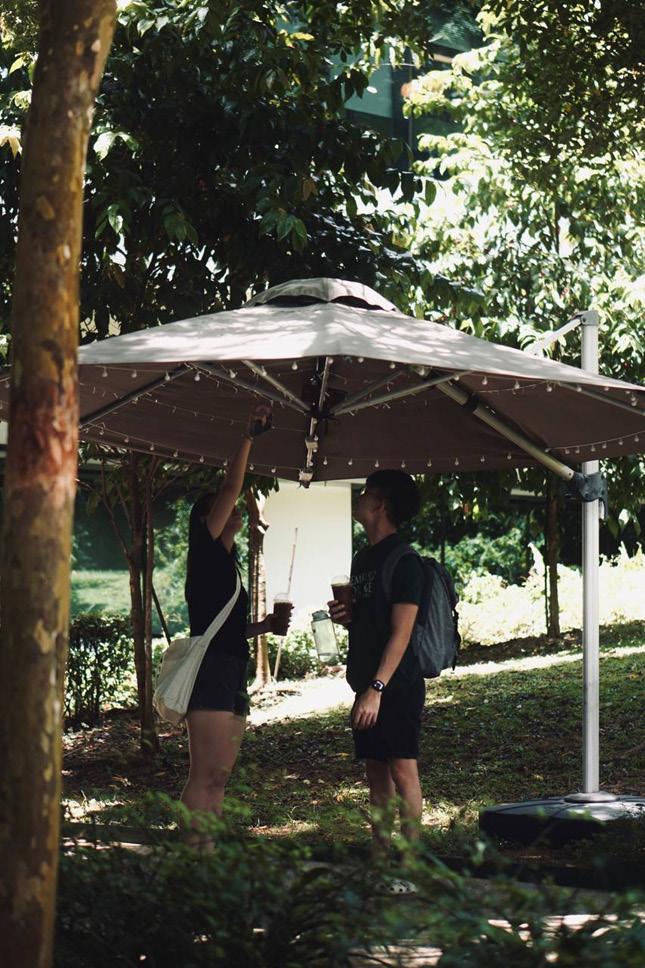


The Residential Colleges near the site aligned neatly with Friedman’s second criterion in Place and Place-Making: inhabiting the space as a necessary condition of living in a “place”. Friedman also claims that “spaces of encounter and/or gathering” (p.155) is another important criterion in the formation of places, which we aimed to create through Fermata’s form of an umbrella that provided shelter.
Simultaneously, our desire to create a unique, once-in-a-lifetime ichi-go ichi-e moment was inspired by Henri Lefebvre’s (1992) fascination with transcendence in everyday urban life and how these moments “break up the banality of the everyday.” Lefebvre characterised such moments as glimpses through time, creating fleeting insights into the future that concurrently conjure memories of the past. However, these moments are fleeting, and as Lefebvre puts it, time “reorients itself like a curl of smoke”. Utilising music and shelter, we decided to create an unrepeatable moment in time that encourages students walking along the transitory path to pause and take a break from their hectic schedules.
4
1 A Japanese idiom referring to a unique and unrepeatable moment.
Figure 1: First encounter.
Lefebvre’s Rhythmanalysis (1992) explores social ideas relating to time and its manipulation in contemporary societies. Lefebvre argues that time has become a commodified and exploited resource, rather than a fleeting entity. We observe time being syphoned away from leisure and reinvested in work.
As Lefebvre posits, music has a cardinal role beyond its cultural phenomenon and is deeply intertwined with our perception of time, space and social structure. He argues that music has the power to disrupt the human condition and the human psyche: “In its relation to the body, to time, to work, it illustrates real (everyday) life. It purifies it in the acceptance of catharsis” (Lefebvre, 1992, p.66). Harnessed as a tool to regulate physiological (to slow down your heartbeat) and emotional responses (make you calm) underneath the umbrella, a carefully curated playlist of songs2 was compiled to create a moment of respite

5 Project Report - Group 3 Fermata 2 See
Appendix A.
Figure 2: Fermata at night.
Form, Development and Set-Up Form

Fermata takes the form of a cantilever umbrella adorned in fairy lights and small mirrors, with nostalgic music emitting from a speaker underneath the canopy. The umbrella is strategically placed so that there are unobstructed sightlines from the ERC, LL, UTR sheltered walkway and the sidepath Cinnamon College. It did not visually obstruct neighbouring amenities and did not physically obstruct those who may not have had the capacity to engage.
Site analysis
Our initial inspiration for our choice of intervention site was Lim’s Defining Model Cities, particularly his claim that “a model city must be one that provides [...] a conducive living environment for its people”. At our intervention site, we initially noticed a design oversight – the unsheltered walkway between the ERC and the Learn Lobe – that we were eager to solve. Site observations also put into perspective the hectic pace of students’ lives; we observed that most students sped up along the path to escape from rain or sun.
Site analysis revealed that students were unsatisfied with the high-traffic and unsheltered transition path. 40% of interviewees rated the site “0” on a scale of 1-5, with 1 being “highly unsatisfied” and “5” being “extremely satisfied”. Passersby tended to increase their pace on the path in order to seek shelter from the elements in adjacent nearby shelters.

On our final site visit before set-up, we identified optimal spot on the side of the path was for the base of the cantilever umbrella and a water point to fill its weighted base. Lighting and audio tests were also conducted; lighting was still visible in daylight and the Bluetooth source in the CSC could connect to a speak underneath the umbrella.


6
UTC2105 - Singapore as a ‘Model’ City
Figures 3 and 4: New elevated spot for umbrella set-up and the view from the CSC room.
Figure 5: Initial plan to tilt the umbrella upwards, creating an “open” headroom that compromised on intimacy.
Set up
During the day of set up, a janitor spectating our process offered assistance after the initial watering point was found to be infested with fire ants. Thankfully, the janitor redirected us to a nearby public restroom and lent us his trolley and pails, enabling us to efficiently fill the umbrella’s base weighing almost 200kg. Without the help of the janitor, we would have resorted to significantly more inefficient ways of drawing water, incurring more time and effort.
Immediately after installation, we realised that the canopy of the umbrella was rather low and could hit the heads of taller passersby. We thus first attempted to tilt the umbrella upwards to create more headroom. However, we realised that that angled position would sacrifice the intimacy of the space, rendering the intervention less effective in encouraging slowing down, and compromising our main aim of Placemaking. Eventually, the umbrella was shifted to an elevated plot of land opposite the initial “optimal” spot we identified, mitigating the headroom issue and retaining the intimacy of the canopy.

7 Project Report - Group 3 Fermata
Figure 6: Hanging fairy lights, mirrors, and the speaker. Fairy lights were arranged to spiral into the centre of the umbrella.






8 UTC2105 -
City
Singapore as a ‘Model’
Figures 7, 8, 9, and 10: Water retrieval and base-filling process, with the help of the janitor.
Figure 11: Trolleys, pails and funnels (unpictured) borrowed from the janitors.
Impacts and Insights
Observation of Public Interactions
We used the CSC room as our vantage point to observe the public’s interactions with Fermata. To our excitement, Fermata immediately captured the attention of passersby, who slowed down to take photographs and videos or bask in the shelter amid the rain or shine.

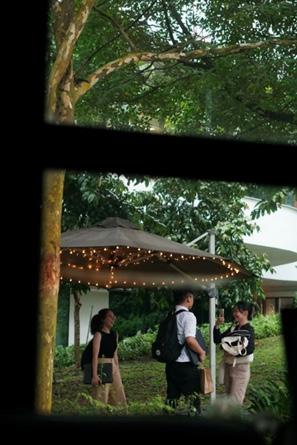
We were initially concerned that commuters were pausing only to take pictures of the novel installation, without meaningfully disengaging from their busy routines. What we observed in the subsequent days soon dispelled our worries. We witnessed commuters pausing under the umbrella in small groups and holding brief conversations. Some were even seen swaying and grooving gently to the music.

9 Project Report - Group 3 Fermata
Figures 12, 13 and 14: Passers-by slowed down to investigate and took pictures of our umbrella.
The highlights of our observational studies occurred on rainy afternoons. We witnessed many passersby rushing from one end of the path, seeking momentary respite under the umbrella, and resuming their rush to the other end of the path. This aligned perfectly what we envisioned for Fermata - a pause in space and time for people to share a moment, sheltered from rain, before resuming their lives.


10
UTC2105 - Singapore as a ‘Model’ City
Figure 15: A pair of passersby pausing and appreciating the music.

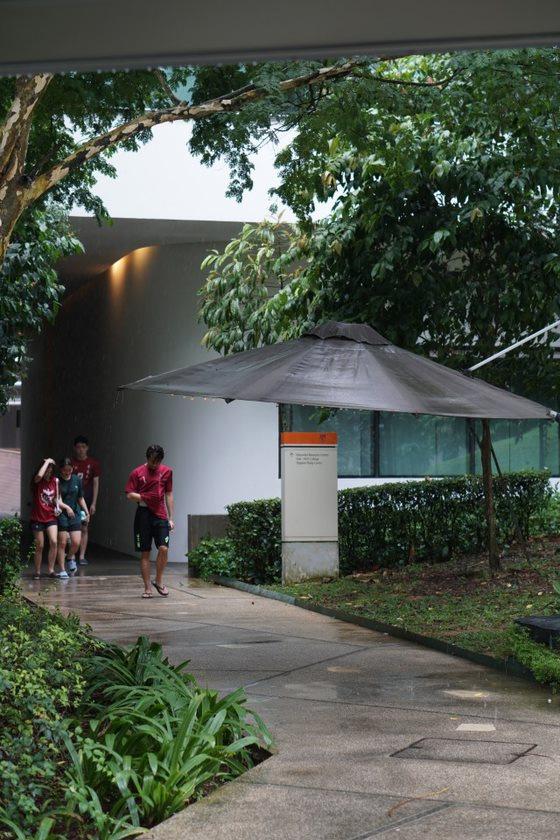



11 Project Report - Group 3 Fermata
Figures 16, 17, 18, 19, and 20: Passers-by seeking refuge on a rainy day, resting under the umbrella, and reading the write-up.
Site Observations
By conducting site observations consistently throughout the week – tallying how many people slowed down and interacted with our installation and analysing the profiles of those who interacted with our project– we aimed to evaluate the efficacy, strengths and engagement of our intervention.3
The team collected the following information during our surveys:
1. Date and time
2. Weather condition

3. Pedestrians’ reaction (slow down and observe/look but not slow down / no reaction)
4. Pedestrians’ group size
Site surveys were carried out twice a day during 1200-1230 and 1800-1830 when the foot traffic was higher.
3 See Appendix B.

12 UTC2105 -
Singapore as a ‘Model’ City
Figure 21: A passerby taking temporary shelter from heavy rain, before continuing their journey.
Interviews and Surveys
We placed the QR codes for our survey under write-ups for Fermata.4 This arrangement allowed us to collect feedback from those who had interacted with the intervention and better understood its aims.


4 See Appendix C.

13 Project Report - Group 3 Fermata
Figure 22, 23, and 24: Writeups were hung up in an accessible spot on either end of the intervention path.
UTC2105 - Singapore as a ‘Model’ City

The survey aimed to discern the prevalence of musical emotions that participants experienced during their interactions with the project. We asked participants to identify with emotional categories that were split by basic (happy/sad) and complex (nostalgic/melancholic) emotions, based on the framework developed by Juslin et al. (2010).



We opted not to survey participants for quantitative measurements of time spent under the umbrella, as we felt that individual perceptions of time are subjective. Even a brief pause can provide a significant respite from the hectic pace of life. Hence, participants were asked to rank how much they felt time slowed under the umbrella on a scale of 1-5, with 1 being “Not at all” and 5 being “It felt like time stopped”.

14
Figures 25, 26, 27 and 28: The team conducting street interviews.
The team also conducted street interviews with random passersby.5 Questions asked were used to evaluate the effectiveness of the project and identify areas for improvement.

15 Project Report - Group 3 Fermata
Figure 29: Flow of Questions Asked During Street Interviews.
5 See Appendix D.
Result Analysis

Evidence suggests that our project managed to slow people down from their busy routines. On average, the percentage of people slowing down when they passed by our installation was 27.2%. This percentage was higher during the first three days (approximately 40%), diminishing towards the end of the week (below 10% on the last day).

The higher percentage of people slowing down during the first three days could be due to the initial heightened curiosity of the new installation. Indeed, many interviewees reported that the emotions generated by the umbrella was that of “surprise” and “intrigue” .6 This suggests the effectiveness of the project in slowing down pedestrians was largely dependent on its novelty. Hence, it may not be a sustainable solution for providing breaks from the busy pace of modern life.
However, we found that our project successfully achieved its intended effect of providing a temporary break from the fast-paced lifestyle for those who paused to engage with it. In the survey, 80% of respondents reported feeling calm after interacting with our installation, while 77.5% agreed that it managed to slow down the tempo of their daily life. The interviews conducted also reflected the soothing effects of Fermata. Val Chong, a Tembusu College resident, shared her “perfect” moment dancing to the music with her friends in the middle of a drizzle while illuminated by the bright fairy lights. 6
16 UTC2105 - Singapore as a ‘Model’ City
See Appendix D.
Figure 30: Percentage of people slowing down against date.
Despite the success of our project in slowing down passersby, we also identified some limitations that need to be addressed. One major limitation is that the draw from our installation was not strong enough to stop commuters who are in a rush. Many interviewees agreed that if they had urgent tasks to attend to, they would not slow down and engage with the installation. This explains why more people engaged with Fermata at night when there were fewer classes and work commitments. It allowed them the peace of mind to take a break and detach themselves for a moment under the umbrella.
Moreover, the project seemed to cater more to those with an appreciation for the arts. The majority of respondents who responded positively to the project and took a pause were artistically experienced or had an interest in arts and music. This is understandable because Fermata relied heavily on the appeal of the art - through the use of fairy lights to improve aesthetics and music to engage the senses - to attract and slow down commuters. While this may be effective in engaging artistic individuals, it may not be as effective in slowing down those who have less appreciation for the arts.


17 Project Report - Group 3 Fermata
Figure 31: Emotions evoked by Fermata.
Figure 32: Responses for how much the intervention slowed one down from their normal pace of life.
UTC2105 - Singapore as a ‘Model’ City
The data also suggests that groups are more likely to slow down and interact with our project. On any given day, the percentage of people slowing down given they are in a group is significantly higher than individuals.


There could be several reasons for this behaviour. One possibility is that being in a group creates a social dynamic that encourages interaction with the environment. People in groups tend to feel more comfortable exploring and engaging with their surroundings, particularly if they were with friends (Mullen & Goethals, 1987). Meanwhile, individuals might feel more vulnerable to judgement when they stopped in the middle of a busy transitory space. Furthermore, group interaction with the installation might also be influenced by social norms and peer pressure, as individuals might feel more compelled to slow down if others in their group are doing so.
These limitations suggest that future interventions may need to consider alternative ways to attract commuters who are less artistically inclined, in a rush and/or alone.
18
Figure 33: Percentage of passersby slowing down when alone, compared to in a group.
Public Reception
The feedback from students was overwhelmingly positive. A Post-it note was placed on one of the posters, requesting that we “keep it up forever.” This sentiment resonated with other students, as evidenced by comments in the Tembusu College Telegram chat and during on-site interviews. Friends even sent videos of their experiences under the intervention to team members, expressing high praise.

19 Project Report - Group 3 Fermata
Figure 34: Fermata writeup with Post-it note reading “PLEASE KEEP THIS UP FOREVER <3”.
We were pleasantly surprised by the overwhelmingly positive feedback received, as our intention with Fermata was simply to offer a modest respite from the busyness of life. This suggests that the intervention resonated with our target audience on a deeper level than initially anticipated. We believe that our project has made passersby more conscious of their busy schedules and the importance of taking a break and relaxing. As a result, they expressed gratitude for the opportunity to pause and unwind provided by our project.







20
UTC2105 - Singapore as a ‘Model’ City
Figures 35, 36, 37, 38, 39 and 40: Praise from the team’s peers.




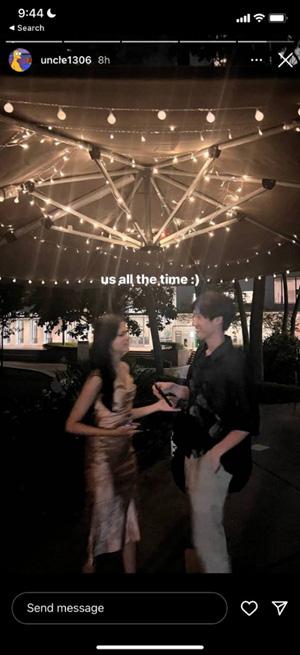
21 Project Report - Group 3 Fermata
Figures 4 1and 42: Passersby posing with Fermata.
Figures 43,44 and 45: Fermata on social media.
Conclusion Summary of Findings
In general, participants who stopped or slowed down appeared uncertain about the project’s purpose, showing curiosity towards the source of the music and the twinkling fairy lights. Nevertheless, this still achieved the project’s goal of creating a temporary pause in their hectic routines.
We observed that the intervention’s effectiveness in creating the ichi-go ichi-e moment relied on the element of surprise, as the presence of the umbrella and music caught passers-by off guard. We noticed higher levels of engagement and interaction during the first two days. However, a decrease in interaction was noted as the novelty of the intervention diminished throughout the week.
Implications of the Intervention
Fermata is a simple form of prefabricated components. Despite its simple execution, it was highly effective and had a significant positive impact during its one-week stint.

Recommendations and improvements
One observation was a significantly lower percentage of solo passersby interacting with the intervention compared to passersby in groups, which concurred with the feedback from street interviews. To address this, sites of similar interventions could be in less open spaces. More enclosed spaces could allow solo travellers to feel less judged and more comfortable with taking the time to fully immerse themselves in the moment.
Verbal feedback also revealed that more forms of activity or stimuli could incentivise more people to slow down. Stronger suggestions to slow down could include placing deck chairs under the umbrella for passersby to rest on and lengthen their “pause”.
22
UTC2105 - Singapore as a ‘Model’ City
References
Friedmann, J. (2010). Place and place-making in cities: A global perspective. Planning Theory & Practice, 11(2), 149–165. https://doi.org/10.1080/14649351003759573
Juslin, P. N., Liljeström, S., Västfjäll, D., & Lundqvist, L.-O. (2010). How does music evoke emotions? Exploring the underlying mechanisms. In J. Sloboda (Ed.), Handbook of music and emotion: Theory, research, applications (pp. 605-642). Oxford University Press. https://doi.org/10.1093/acprof:oso/9780199230143.003.0022
Lefebvre, H. (1992). Rhythmanalysis: Space, time, and everyday life. Bloomsbury Academic, an imprint of Bloomsbury Publishing PIc.
Mullen, B., & Goethals, G. R. (1987). Theories of group behavior. Springer New York.
23 Project Report - Group 3 Fermata
Appendix A: Music Selection

Tempo
Tempo was a key musical element that allowed passers-by to slow down their pace of life. The tempo of the songs fell below 90 BPM, syncing with the ‘tactus’ (pulse) of the typical human heart rate of 60-100 BPM (Harvard Medical School, 2020), which can subconsciously slow down one’s heartbeat. In a 2016 study examining the Influence of Tempo and Rhythmic Unit in Musical Emotion Regulation, the augmentation of a slower tempo invoked the emotional perception of sadness, with other terms such as relaxing also associated. The study also concluded that tempo has a profound impact on determining if songs are happy or sad. The liberal use of tempo rubato ‘robbed time’, such as in A Song For You (Donny Hathaway) and Vincent (Don Mclean), the removal of strict tempo gives back time to the performer, allowing listeners to become engrossed in the moment.The use of half-time (a technique where the emphasis of the beat is halved, so a 4/4 song sounds like 2/2), where the beat emphasis halves in frequency.
Appendixes

24 UTC2105 - Singapore as a ‘Model’ City
Annotated circumplex emotion model (Fernández-Sotos et al., 2016)
Listeners would perceive the music to be slower despite no change in tempo. Songs that employ this technique include Imagine (John Lennon), Slipping through my Fingers (ABBA).
Mode
In general, major keys sound happy, cheerful and light, while minor keys are sad and dark. The majority of songs use key signatures with flat accidentals, which contribute to softness, warmth and melancholy (Shanika, 2018) rather than the brighter key signatures that contain sharps. “With its bittersweet palette of major and minor chords” (Brown, 2010) creating an overall sense of happiness, while retaining melancholic undertones. A Song For You (Donny Hathaway) and Slipping Through My Fingers (ABBA) are notably written in F major, comprising of a single b flat accidental which is characterised by “at once full of peace and joy, but also expresses effectively a light, passing regret—a mournful, but not a deeply sorrowful feeling. It is, moreover, available for the expression of religious sentiment.” (Buja, 2022) A Song
For You, for example, is mainly played in the relative minor key of D despite its home chord of F major. The song only resolves to the home key at the end of each passage. Additionally, the incorporation of 7th chords further augments feelings of yearning to be resolved to the home chord.
Chromaticism
In Time in a Bottle (Jim Croce), A Song For You (Donny Hathaway) and Imagine (John Lennon), harness chromaticism (movement by semitones), used in the bassline, chords, or as a musical ornamentation. The chromatic effect of passing notes that don’t belong in the key signature creates unease, and by intentionally delaying the resolution of dissonance, invokes feelings of yearning (Kamien & Kamien, 2021)
Played in moving steps, the dissonant notes are ‘forgiven’ by our ears when eventually resolved to a note that belongs to the key signature. Use of chromaticism (movement by half-steps) It has long been used to evoke grief, loss, or sorrow (Kamien & Kamien, 2021).
Lyrics
Although musicality plays the primary role in augmenting emotional response, the lyrics supplement the feelings if audiences choose to tune in to the music.
Common themes in the compilation describe love, regret, and lamenting the past.
Time period of songs
The time period of chosen songs ranged from the late 1960s to the early 1980s, utilising well-known songs from a bygone era. This adds to the nostalgic factor that the intervention aims to create.
Volume of music
The speaker that was set up underneath the umbrella was set to a volume such that the music could only be clearly heard once within the umbrella’s radius. This encourages participants to stand underneath the umbrella to experience the intervention in full.
References
Brown, H. (2010, February 24). Don McLean interview: Why I had to write ‘Vincent’. The Telegraph. Retrieved April 17, 2023, from https://www.telegraph. co.uk/culture/music/rockandpopfeatures/7264618/Don-McLean-interview-WhyI-had-to-write-Vincent.html
Buja, M. (2022, May 26). How you should feel in the key of F Major. Interlude. Retrieved April 10, 2023, from https://interlude.hk/feel-key-f-major/
Fernández-Sotos, A., Fernández-Caballero, A., & Latorre, J. M. (2016). Influence of tempo and rhythmic unit in Musical Emotion Regulation. Frontiers in Computational Neuroscience, 10. w\https://doi.org/10.3389/fncom.2016.00080
Kamien, R., & Kamien, A. (2021). Music: An appreciation. McGraw Hill. Shanika, S. (2018, May 23). How does a song’s key affect its sound? TakeLessons Blog. Retrieved April 10, 2023, from https://takelessons.com/blog/how-musicaffects-emotions
What your heart rate is telling you. Harvard Health. (2020, August 30). Retrieved April 10, 2023, from https://www.health.harvard.edu/heart-health/what-your-heartrate-is-telling-you
25 Project Report - Group 3 Fermata





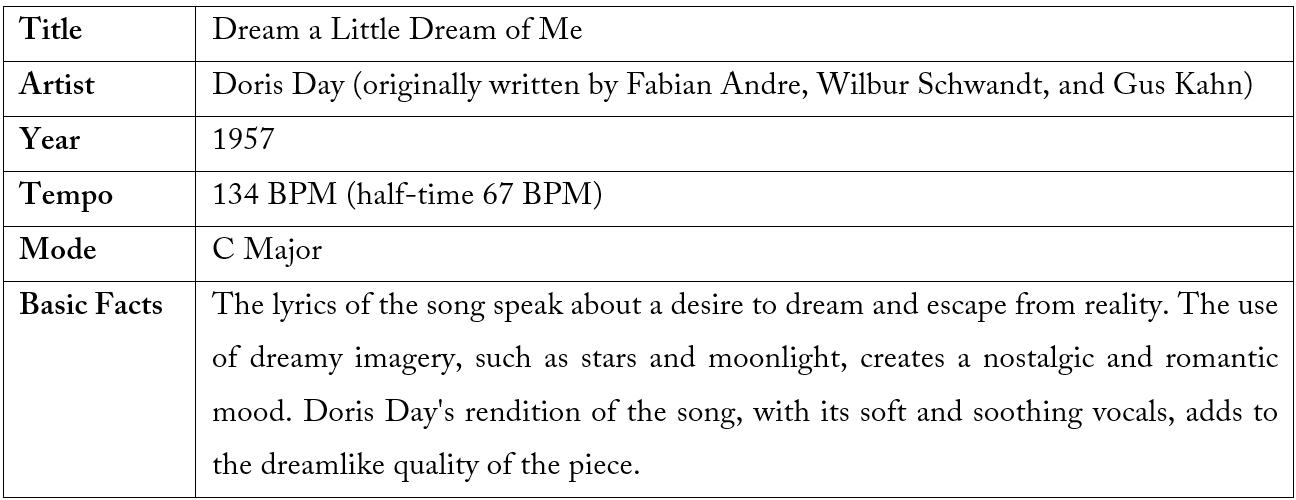

26 UTC2105 - Singapore as a ‘Model’ City




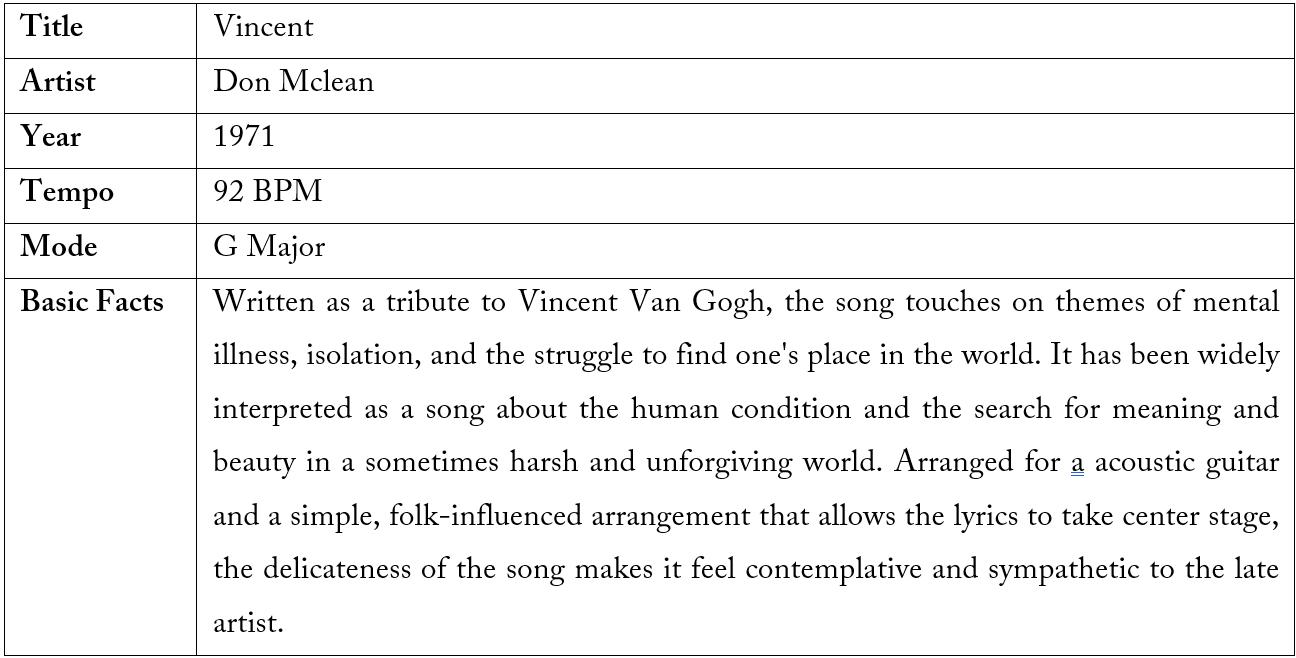
27 Project Report - Group 3 Fermata





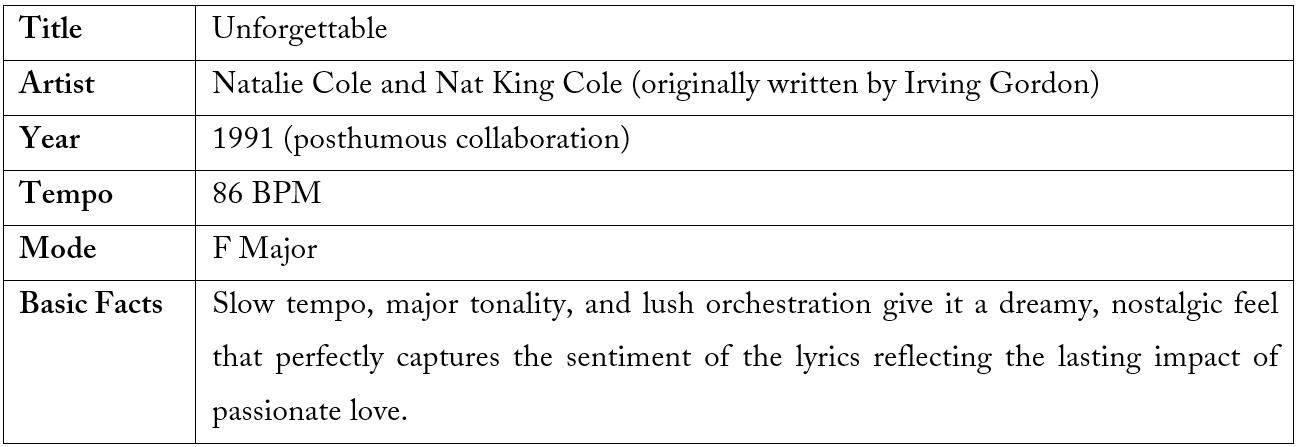
28 UTC2105 - Singapore as a ‘Model’ City
Appendix B: Site Study
https://docs.google.com/spreadsheets/d/1CLFXtSEv6xmJFwacmeS2L2ONb50BVgqtMKlSfU1CpQ/edit
Appendix C: Survey Questionnaire and Results
https://drive.google.com/drive/folders/1EKW0KLdMGE_ AA6Gagr31J9sX5IAMzWtp?usp=sharing


29 Project Report - Group 3 Fermata
"
����
[fermata]

Th s ntervent on s part of the modu e UTC2105 Singapore as Model C ty? Thank you for your help n fil ing out th s feedback form
����" encourages S ngaporeans to momentari y break free from the r fast-paced lifestyles and appreciate unique suspended moments in time The work a ms to provide a temporary resp te for busy pedestrians on a transi ory path offering them a chance to pause and detach from the constant rush under the shade of a large canti ever umbrel a
* ndicates requ red question
1.
How did "����" make you feel? *
Tick al that app y
Nosta g c - ong ng
Happy - e ated
Loving - tender
Ca m - content
Sad - melanchol c
Angry - rritated
Moved - touched
Interested - expectant
https://docs.google.com/forms/d/1jKk0akF7qixSGhTSOJBwDiW7pqEHbwY9eknJRBxux4Q/edit 1 3
Appendix D: Interview Transcripts
Interview 1: Val Chong, a Tembusu resident
Nathan: Did the project manage to make you slow down?
Val: YES!
Nathan: That’s good to hear! Can you describe what kind of emotions you felt during your interaction with our project?
Val: I remembered telling my friends like “Omg, this project made my entire week”. Cause I was coming back from a very tiring lesson and was having a very bad day, and [I was with] my friends who were very stressed up because we were from music school, and they are not from tembu... And we walked past the umbrella and were like “oh my god, has this always been here?” and I was like “No! I came here multiple times and I have never seen anything like that”. And then there was this music that was playing, I think it is a popular Tik Tok song?... Anyway, we started dancing, and oh yeah, it suddenly started raining! So there were added emotions, and it felt like a Kdrama moment! *laughs*. So we were really having a lot of fun, and then we had some other friends pass by and we were like “come and join us!”... So I was feeling very happy that day, because of it [our intervention].
Nathan: You are like, our target audience! *laughs*
Marcus: So it’s like, everything aligns, like it was raining, it was dark, the lights were on...
Nathan: So what were the elements that caught your attention the most?
Val: The lights. And it was such a perfect moment, because it was raining. I feel like if it’s just the lights, it would not feel as impactful. Also the music.... So light, rain and music... the whole thing!
Nathan: Lets say, if people do not slow down [when they cross our intervention], what do you think why they don’t?
Val: ... I think time of the day is very important, because why would they stop for an umbrella when there is sunlight? So maybe at night would make more sense? Also the destination, whether they are rushing to somewhere else. For example I was just walking to Octobox, and I was not in a rush, so I just took my time to slow down and immortalise the moment I was in.
30
City 4/18/23, 12:13
���� [fermata]
UTC2105 - Singapore as a ‘Model’
AM
4/18/23, 12:13 AM [fermata] https://docs.google.com/forms/d/1jKk0akF7qixSGhTSOJBwDiW7pqEHbwY9eknJRBxux4Q/edit 2 3 2. Mark on y one oval Not at al 0 1 2 3 4 5 It felt l ke time stopped This content is neither created nor endorsed by Google.
much did this intervention slow you down from your normal pace of life? * Forms
How
Marcus: You talk about this moment right, but do you have any documentation to record it?
Val: I do! I posted it on my IG!
Marcus: Can you please send it to us?
Val: SURE!
Interview 2: Lydia, a Tembusu resident also enrolled in UTC2105
Nathan: Did the project make you slow down?
Lydia: Yes.
Nathan: So what were your emotions while engaging with the installation?
Lydia: I think when I first saw it I was very intrigued, then I read the project poster and it suddenly made sense to me.
Nathan: Ah yes, so like it clicked?
Lydia: Yes, it clicked!
Nathan: So what were the elements that caught your attention?
Lydia: Cause I went at night, so it was the light for me. And only when I got nearer did I hear the music.
Marcus: You went there after the formal dinner is it?
Lydia: Yeah
Nathan: Did you take pictures?
Lydia: Oh yeah, why didn’t I think of that? Cause it was like a passing thing, so I didn’t think of taking any pictures. It’s kinda like a transitory space thing you know...
Nathan: *laughs* Okay, let’s say you didn’t stop at the installation... What do you think are some reasons why people do not want to stop?
Lydia: No time, like rushing off?
Marcus: Do you think there is anything we could do to achieve the aims, or what we can do differently?
Lydia: I think people would only purposefully stop if there is something that is right in front of them, instead of just being (part of) the surroundings...
Nathan: So you think it’s not interactive enough?
Lydia: Yep I think maybe the interactive element, like if you want people to stop, there should be a reason why they need to stop... Like if they didn’t read the posters, they would just walk through it... Like there is no incentive to stop...
Marcus: Especially if there is no time...
Nathan: From our observation, we noticed people tend to stop when they walk in a group. Do you think that is true?
Lydia: Yes I agree... Cause you feel kinda exposed when you just stand there alone... like people would question you, or think that you are about to ask them some survey questions or something HAHA
Nathan: HAHA I see makes sense... I think that’s mostly it, thank you!!
Interview 3: 2 Girls, who were more comfortable responding in Mandarin. Translated in brackets
Faith: 这是你第一次看到这个工程吗?(Is this your first time seeing this intervention?)
Girls: 嗯,这是我第一次。(Yes, this is my first time)
Faith: 你们有慢下来或者停下来吗?(Did you guys slow down [under the umbrella]?)
Girls: 一开始就很惊喜就像慢下来,就是看不出如果是自能,验证一下, 对。(At first, I was very happy/surprised and slowed down, but I wanted to find out whether [the music] was automatic and wanted to check it out.)
Faith: OKOK, 那么, 你们能分享你们心里的感觉吗?你站在雨伞下的时
候。(Could you share with us your emotions when you were standing under the umbrella)
Girls: 就是一瞬间,后面就有停下来听, 就很惊喜,对。然后就是很想要研
究是不是自能的还是人为操控的。(At that moment, I stopped to listen, and I was pleasantly surprised. Yes. Then I wanted to find out whether the music was automatic or controlled by a human.)
Bluetooth. When you were walking past, which element caught your attention?)
Girl 1: 因为她之前跟我说就是那音乐— (Because before she told me about the music–)
Girl2: 就是我之前路过,我听到过一次,但是我之前就是以为它是一直一直放 的。就是出来透气的时候,想到她还没听到,就把他抓过来,想想是不是自 能的。(So I passed by initially and heard the music once, but I assumed that the intervention was a permanent installation. When I came out to take a breath of fresh air, I remembered she hasn’t heard the music, so I dragged her here to think about whether the music is automated or not.)
31 Project Report - Group 3 Fermata
Faith: 你是听到的,是吗?(So you heard it first, right?)
Girls: 对,很好耶,很好。(Yes, [the intervention] is very good, very good.)
Faith: 你认为为什么有时,人们不会慢下来。(Why do you think people don’t slow down at times?)
Girls: 他们可能不知道。(Maybe they don’t know.)
Faith: 好的,那就这样了!谢谢你们。(Alright, that’s all! Thank you, guys.)
Girls: 谢谢!(Thank you!
Interview 4: An architecture student who passed by our project
Nathan: Has our installation slowed you down?
Architecture student: Yes, I would slow down, but not stop.
Nathan: What do you feel when you engage with it?
Architecture student: it’s quite vibey... I would stand down there and talk to my friends if I was with them. But usually, I’m not, so I would not stop.
Marcus: You are an archi [architecture] student right? Can I ask you an additional question?
Architecture student: Yes sure.
Marcus: Why do you think this installation is in this place?
Architecture student: I think visually it creates this sort of boundary or space... it makes you feel like you are entering a different zone... When you pass through a boundary your mental state changes.... so this creates a different atmosphere or ambience... and puts you into a different relaxation mode, compared to the surrounding environment...
Nathan: What were the elements that caught your attention?
Architecture student: I guess it is the shelter because it really caught me off-guard... because it just appeared out of nowhere... I wouldn’t say it is very random [in terms of where it is situated], but it stands out a lot compared to its surroundings.
Nathan: As you know, the aim of our project is to slow people down from their busy routine... but if people do not slow down, what do you think are the reasons why?
Architecture student: I would say it’s because people are more focused on getting somewhere or doing something, that’s why they choose not to slow down... but I would think that most people would slow down because it catches their interest...
Nathan: I see, that’s mostly it, thank you!
UTC2105 - Singapore as a ‘Model’ City
Interview 5: 3 girls who we observed slowing down and admiring our umbrella for a short while
Nathan: What makes you guys slow down?
Girl 1: It was just new and very pretty...
Nathan: Which particular element intrigues you?
Girl 2: The light
Girl 3: The music
Nathan: Did you feel any particular emotions while engaging with the installation?
Girl 1: I guess, surprise, mostly.
Girl 2: *intelligible* ....there is some sort of special element...
Nathan: Thank you, those are all the questions!

32
My most significant learning point was embracing criticism with openness and flexibility. The initial critique of our proposal was demoralising for the team. However, it ultimately compelled us to make a substantial conceptual shift in our project, relinquishing one of its original aims — highlighting the design gap in the unsheltered pathway between the LL and the ERC.
Initially, since our site selection was based on this specific issue, I was reluctant to abandon the intervention’s aim to address the design gap. I perceived discarding this concept as forfeiting the very objective that motivated our site choice. Nevertheless, faced with the glaring tension between our two concepts pointed out by the critique, we had to choose one to sacrifice.
In retrospect, being forced to sacrifice one of the ideas taught me to appreciate the evolution of our ideas, recognising that although our inspiration stemmed from the design gap, the intervention transformed to address another observed issue: people rushing past the transitory space without pausing.
Embracing this evolution taught me the importance of remaining open to change. Learning not to over-invest in not-so-good ideas and learning when to let go of them is a quality easily transferable to other endeavours. In policymaking, the career I hope to pursue in the future, involves a big deal of learning from feedback, even if the feedback is unexpected or unplanned. Learning to tailor a project’s aims to be clear and concise for optimal understanding, even at the tradeoff of conflicting conceptual aims, is thus applicable and important.
Another enduring lesson from this intervention was focusing on the project’s impact on its intended audience. I initially believed that the concept of placemaking alone wouldn’t provide a robust enough rationale for the project. I typically feel a need to justify precise, “concrete” objectives for external-facing projects to ensure their rigour. However, the reactions of passers-by revealed that an effective project simply needs to achieve its intended goal with its target audience.
Our project’s goal was to slow people down from their hectic pace of life, not to educate them on the purpose of the project or placemaking. By physically distancing our research from the intervention itself (the write-ups were placed at either end of the paths, so participants could voluntarily read them after interacting with the intervention), participants were not nudged to interact with the project in a certain way and were free to interact with the installation however they chose. This allowed the project to fulfil its purpose without overemphasising our personal motivations.
Consequently, I was pleasantly surprised by the number of ways passersby interacted with it and the overwhelmingly positive feedback they left us. Observing from a hidden window in the Learn Lobe’s CSC Room, I was excited to see people interact with the intervention in ways we never anticipated. For example, I did not foresee the project becoming an Instagrammable spot, nor did I expect people to expressly bring their friends out to see the intervention and hang out together under the umbrella. The open-ended nature of our project thus allowed for diverse interpretations and interactions, which strayed far from our predictions but resulted in more organic and memorable behaviour. Initially, I feared our intervention idea might be too simple and lack “proof” of rigour. However, I eventually appreciated the simplicity of our project and realised that thorough consideration of contingencies also contributed to its rigour.
Given a bigger budget and more expertise, I think it would have been extra impressive if our group had the chance to build our own shelter. Designing and building our shelter would have allowed us to incorporate more takeaways from URA’s sharing on usability and would have allowed for more flexibility and innovation in the shelter’s design, better adapting it to the site and its purpose.
It’s also worth noting that the project’s success also reaffirms these learning points — had it not gone so well, my takeaways would have probably been less impactful.
Overall, however, I was still really proud of the final product and happy that its execution went as smoothly as it did. Through flexibility, openness, and focus on our audience, we transformed our intervention into an impactful and memorable moment for those who engaged with it.
33 Project Report - Group 3 Fermata
Reflections Faith
Marcus
For me, my most significant learning moment was learning to let go: of expectations and of ideas.
Expectations:
I had originally enrolled in UTC2105: Singapore as a ‘Model City’ upon recommendation from my seniors: Chee Meng and Andrew. I felt that the module was especially akin to the interests of architectural students, giving us an opportunity to ‘flex’ creative muscles and exercise our skillset. I had seen Cash Love Clout several times both in real-life and on social media and became very caught up in the idea of their project, essentially worshipping it in essence. I was especially excited to take on the intervention project tasked to students of this module, but I placed a lot of expectations on myself to conceptualise an intervention that would be both ambitious and exciting, producing a project that would be equally as ambitious and beautiful as my seniors. It clouded my judgement during the initial stage of the project; the obsession with their execution didn’t allow me to develop a concrete idea.
A dear friend of mine, whom I was collaborating on another project with, encouraged me that in order to produce a project that I consider equally good or better than what I consider the gold standard, I had to break free from the expectations I had set for myself, which would free myself to conceptualise something original and unexpected. I liberated myself from my own expectations and found the spark to the idea that my team would eventually manifest as the Fermata.
The learning moment stems from the recognition of the different topologies of play. In the design of urban spaces, play can be incorporated to engage the public. A public intervention can adopt different forms, and by approaching our own intervention project through a different scope, and incorporating a different topology of play in our intervention, we were able to evolve the idea and develop a nuanced project that was bold, sophisticated and importantly, gave me (and I’m sure Faith and Nathan as well) an immense amount of satisfaction to see Fermata achieve its objectives.
Ideas:
During the ideation process, I think myself and the team had the tendency to fixate on ideas and theories. During the first consultation, we proposed 3 ideas and did mockups for all of them. Given the investment, I think we were all quite invested in the ideas despite them showing flaws and overall weak ideas. Learning to drop all the previous ideas and redevelop a new one was in that moment quite agonising, however I am glad to have done so, as our final intervention was the result of the continuous evaluation and rigour that we strived for. As we developed the Fermata proposal, we were (in my opinion) quite harshly critiqued by the class due to perhaps proposing quite a few theories that individually are very clear but together don’t complement each other. To let go of one of the main theories in order to clarify and refine the overall idea was crucial and benefit the project overall.
I am glad to have experienced these learning moments over the project. I strongly believe that without facing these personal and external obstacles, it wouldn’t have allowed Fermata to develop into its refined concept and execution.
UTC2105 - Singapore as a ‘Model’ City

34
Nathan
Overall, I thoroughly enjoyed the whole process of the intervention project. Through the project, I consolidated the knowledge I acquired from UTC2105, and learned some valuable insights about myself.
When I first saw the videos and examples of past intervention projects in class, I was very intrigued by the creativity and ingenuity in their link to Singapore as a Model City. I felt inspired and wanted to craft a meaningful intervention project that would be both innovative and related to the module content. However, coming up with an idea proved difficult to me, because I could not settle on which theme to focus on among the many ones explored in our module. My group mates also leaned towards interventions that were more artistic in nature, which admittedly is not my strength.
In the end, our group identified the design flaw that was the lack of shelter at the pathway between ERC and Tembusu, and wanted to address this through the intervention. However, I struggled to tie our project back to the concepts taught in Model city. Therefore, I had to actively review the concepts I had learned to make conceptual connections to our intervention. I identified that Fermata matched the definition of a place-making device, as it served to improve the quality and functionality of the pathway by sheltering commuters from the elements, and inviting them to take a break. I also found our use of lights and music to resemble a form of play topologies, in particular play as Simulation. For instance, Fermata activated the visual and auditory senses of passers-by in hopes of disengaging them from their busy pace of life, similar to how simulation “involves forgetting, disguising or otherwise escaping one’s usual self and one’s place in the world” (Stevens, 2007). It was an insightful moment for me that the concepts taught in class can actually be connected to, and applied in our intervention project. Hence, I am thankful that the project allowed me to consolidate the knowledge I learned in a meaningful and practical way.
I also learned a lot from working with my talented and competent teammates. Faith has strong writing ability and high attention to details, hence she was very effective at ensuring our documentation was up to high standard. I was also very impressed by Marcus’s rich creativity, artistic visions and competent design skills. He came up with brilliant ideas (such as choosing the name Fermata for our project) and designed all the graphics for the installation. I am grateful for the opportunity to work with them, because the intervention project required the skills my teammates possess, which were also areas I still have much to grow in.
I also regret that my strengths as a Computer Science student did not sufficiently shine through in the project, and wish I could have contributed more meaningfully to it. While I did try my best to handle data collection and analyse the results and statistics in a rigorous and systematic manner, I felt the project’s execution and documentation would still be successful were I replaced by another student from a different major/ faculty. While disappointed by the extent of contribution I had, I also recognized my limitations and treated this project as a learning opportunity for myself, as I learned to navigate a different group dynamic and work on unfamiliar project requirements.
All in all, I enjoyed the process of ideating, setting up, and executing the intervention project. I am satisfied that the project generated exceedingly good public reception, and relieved that it went as smoothly as it did.
References:
Stevens, Q. (2007). Play and the Urban Realm. In The Ludic City: Exploring the Potential of Public Places (pp. 26-53). London & New York: Routledge.
35 Project Report - Group 3 Fermata




































































